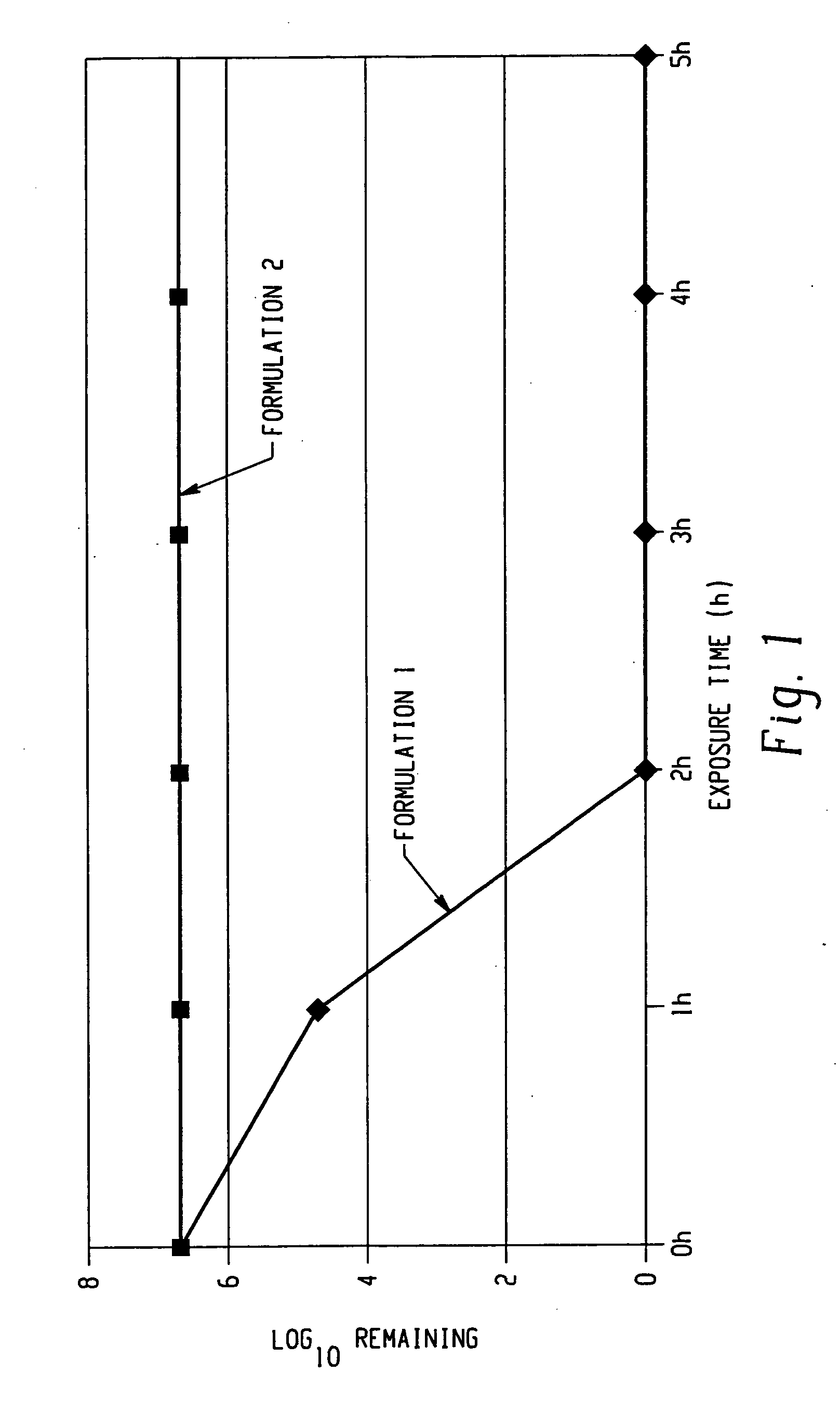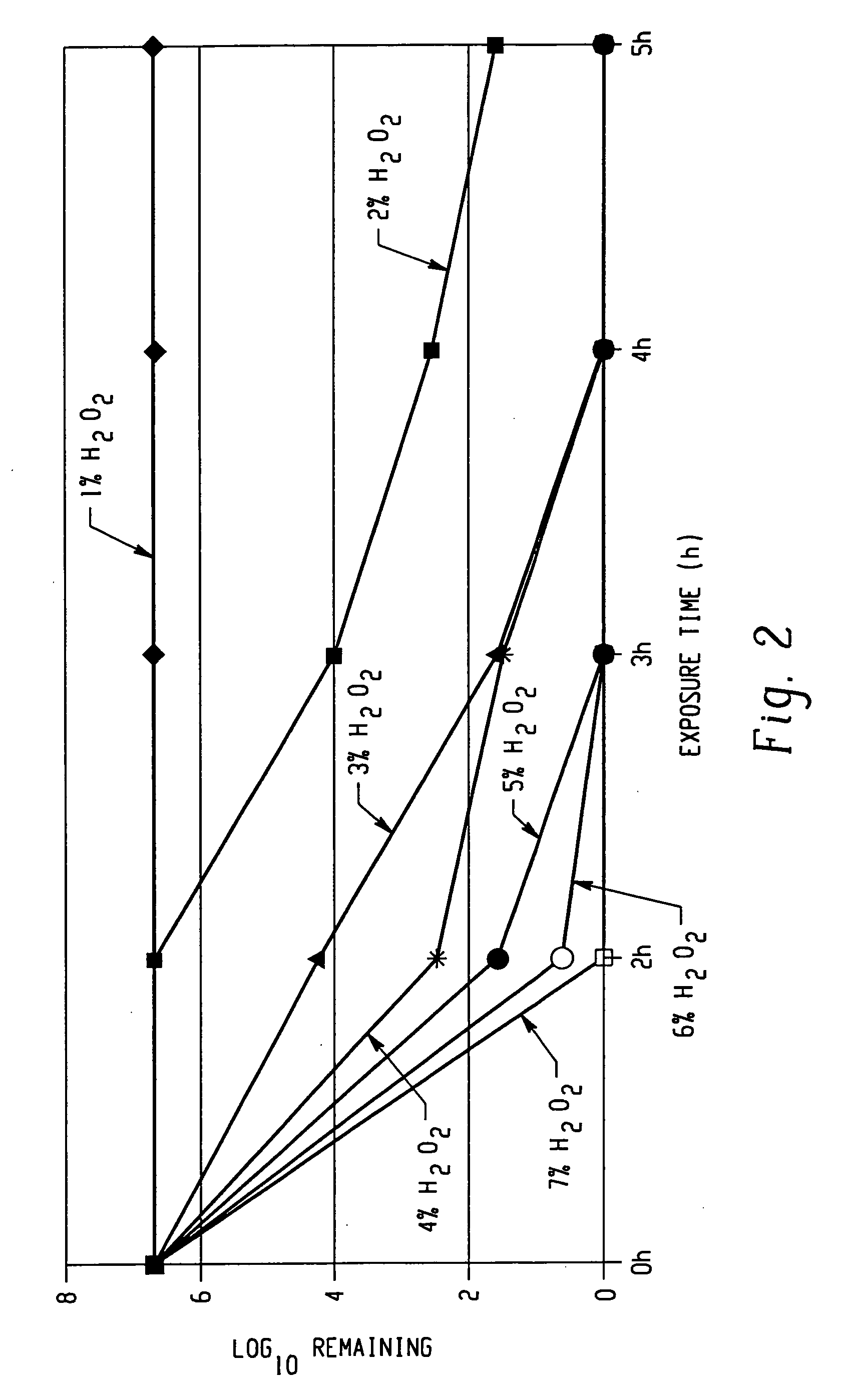Cleaning and decontamination formula for surfaces contaminated with prion-infected material
a technology of prion and prion, which is applied in the field of biological decontamination, can solve the problems of ineffective breakdown, tissue damage, cell death, etc., and achieve the effect of easy culture and detection, and effective human model
- Summary
- Abstract
- Description
- Claims
- Application Information
AI Technical Summary
Benefits of technology
Problems solved by technology
Method used
Image
Examples
example 1
Effect of Hydrogen Peroxide on IFDO
[0087] The following formulations are prepared, as shown in TABLE 1. Formulation 1 includes 7% hydrogen peroxide. Formulation 2 is prepared without hydrogen peroxide, to act as a control.
TABLE 1ComponentFormulation 1Formulation 2Deionized water68.619788.6139Citric Acid0.00030.0061Natrosol 3301.01.0KOH0.0220.022Sorbitol10.010.0HEDP0.0080.008Oxyrite0.150.15Cobratec 9390.20.2Hydrogen peroxide20.00(35% solution)KOHAs needed to bring—the pH to 5.5
[0088] The two formulations are tested against an ileal fluid dependent organism (IFDO). This organism has been shown to be an effective model for human and other prions since it shows comparable behavior patterns to prions when exposed to a variety of environments, such as disinfection and sterilization. The organism was first extracted from ileal fluid (hence its name) by Burdon (Burdon, J. Med. Micro., 29: 145-157 (1989)). The organism is readily cultured and detected in the laboratory. For example, the o...
example 2
Effect of Hydrogen Peroxide Concentration on IFDO
[0092] Formulations are prepared as for Formulation 1 of Example 1, but with different concentrations of hydrogen peroxide (the quantity of water is adjusted accordingly).
[0093] Suspensions of IFDO in the different formulations are tested as for Example 1. FIG. 2 shows the effect of hydrogen peroxide concentration over time. The formulations containing 1%, 2%, 3%, and 4% by weight hydrogen peroxide, respectively, all show measurable levels of IFDO after 3 hours of exposure. At 5% hydrogen peroxide or above, the formulations show no detectable IFDO after 3 hours of exposure. Only the 7% hydrogen peroxide formulation shows no detectable IFDO after 2 hours of testing.
example 3
Effect of Hydrogen Peroxide on Prion Contaminated Materials
[0094] Stainless steel wires are inoculated with brain material contaminated with Scrapie (sheep) prion protein. The wires are air dried overnight. Sets of the wires are soaked for one hour in one of the following: deionized water; Formulation 1 of Example 1 (includes 7% hydrogen peroxide plus surfactants, etc.); and 7% hydrogen peroxide in deionized water. The wires are removed from the liquid, rinsed in deionized water and extracted to remove remaining protein and biological material. Samples of the extracts are separated by SDEPAGE and Western blotted with an anti-scrapie protein antibody to detect the presence of absence of scrapie following the treatment. A control sample, which undergoes no soaking, is also extracted and tested. The results are as shown in TABLE 2
TABLE 2Percentage of Samples Testedwhere Prion (Scrapie) isTreatmentDetectedControl (no treatment)100%Water 95%7% Hydrogen Peroxide100%Formulation 1 0%
[0095...
PUM
| Property | Measurement | Unit |
|---|---|---|
| molar concentration | aaaaa | aaaaa |
| molar concentration | aaaaa | aaaaa |
| molar concentration | aaaaa | aaaaa |
Abstract
Description
Claims
Application Information
 Login to View More
Login to View More - R&D
- Intellectual Property
- Life Sciences
- Materials
- Tech Scout
- Unparalleled Data Quality
- Higher Quality Content
- 60% Fewer Hallucinations
Browse by: Latest US Patents, China's latest patents, Technical Efficacy Thesaurus, Application Domain, Technology Topic, Popular Technical Reports.
© 2025 PatSnap. All rights reserved.Legal|Privacy policy|Modern Slavery Act Transparency Statement|Sitemap|About US| Contact US: help@patsnap.com



